Sainsbury's Organizational Behaviour: Culture, Power & Teamwork
VerifiedAdded on 2023/06/06
|12
|4534
|140
Report
AI Summary
This report provides a comprehensive analysis of organizational behaviour, focusing on the influence of culture, politics, and power on individual and team behaviour within Sainsbury, a major UK supermarket retailer. It evaluates methods for motivating individuals and teams to achieve organizational goals, differentiating between extrinsic and intrinsic motivation. The report also examines the knowledge, skills, and experience necessary for effective teamwork, highlighting the benefits of team collaboration and contrasting effective versus ineffective teams. Group development theories are explored, and the report reflects on the value and relevance of effective team working for influencing behaviour in the workplace, ultimately aiming to improve organizational performance and employee engagement.
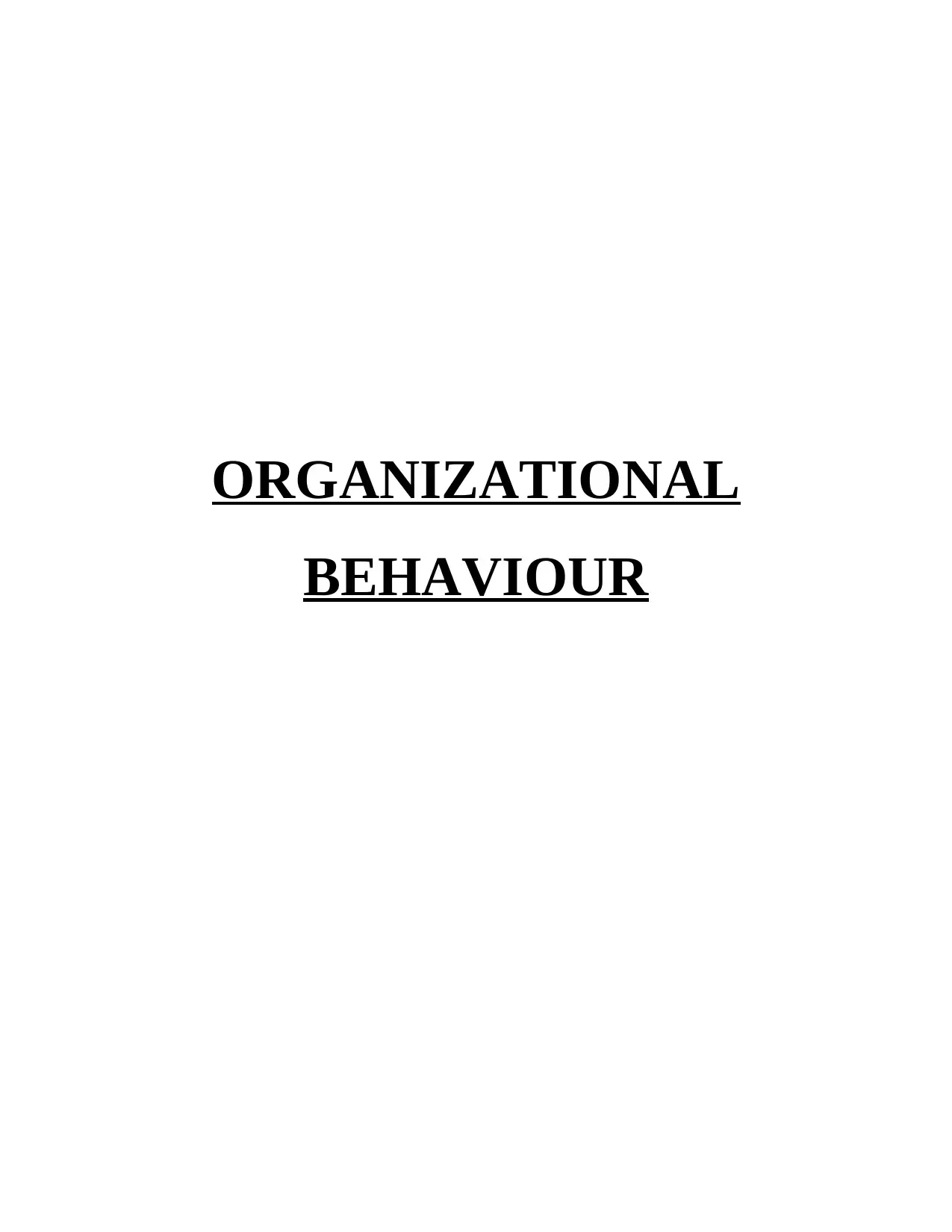
ORGANIZATIONAL
BEHAVIOUR
BEHAVIOUR
Paraphrase This Document
Need a fresh take? Get an instant paraphrase of this document with our AI Paraphraser
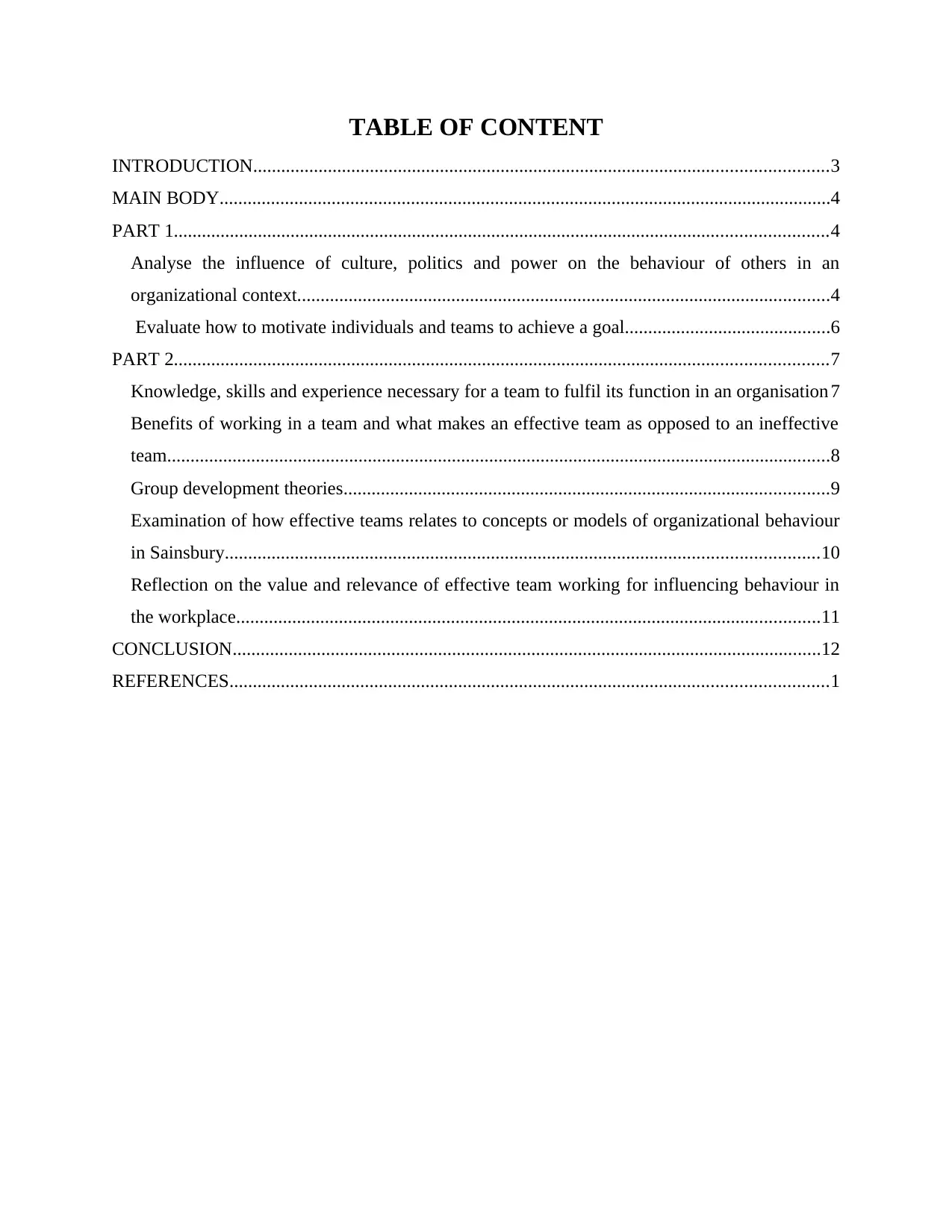
TABLE OF CONTENT
INTRODUCTION...........................................................................................................................3
MAIN BODY...................................................................................................................................4
PART 1............................................................................................................................................4
Analyse the influence of culture, politics and power on the behaviour of others in an
organizational context..................................................................................................................4
Evaluate how to motivate individuals and teams to achieve a goal............................................6
PART 2............................................................................................................................................7
Knowledge, skills and experience necessary for a team to fulfil its function in an organisation 7
Benefits of working in a team and what makes an effective team as opposed to an ineffective
team..............................................................................................................................................8
Group development theories........................................................................................................9
Examination of how effective teams relates to concepts or models of organizational behaviour
in Sainsbury...............................................................................................................................10
Reflection on the value and relevance of effective team working for influencing behaviour in
the workplace.............................................................................................................................11
CONCLUSION..............................................................................................................................12
REFERENCES................................................................................................................................1
INTRODUCTION...........................................................................................................................3
MAIN BODY...................................................................................................................................4
PART 1............................................................................................................................................4
Analyse the influence of culture, politics and power on the behaviour of others in an
organizational context..................................................................................................................4
Evaluate how to motivate individuals and teams to achieve a goal............................................6
PART 2............................................................................................................................................7
Knowledge, skills and experience necessary for a team to fulfil its function in an organisation 7
Benefits of working in a team and what makes an effective team as opposed to an ineffective
team..............................................................................................................................................8
Group development theories........................................................................................................9
Examination of how effective teams relates to concepts or models of organizational behaviour
in Sainsbury...............................................................................................................................10
Reflection on the value and relevance of effective team working for influencing behaviour in
the workplace.............................................................................................................................11
CONCLUSION..............................................................................................................................12
REFERENCES................................................................................................................................1
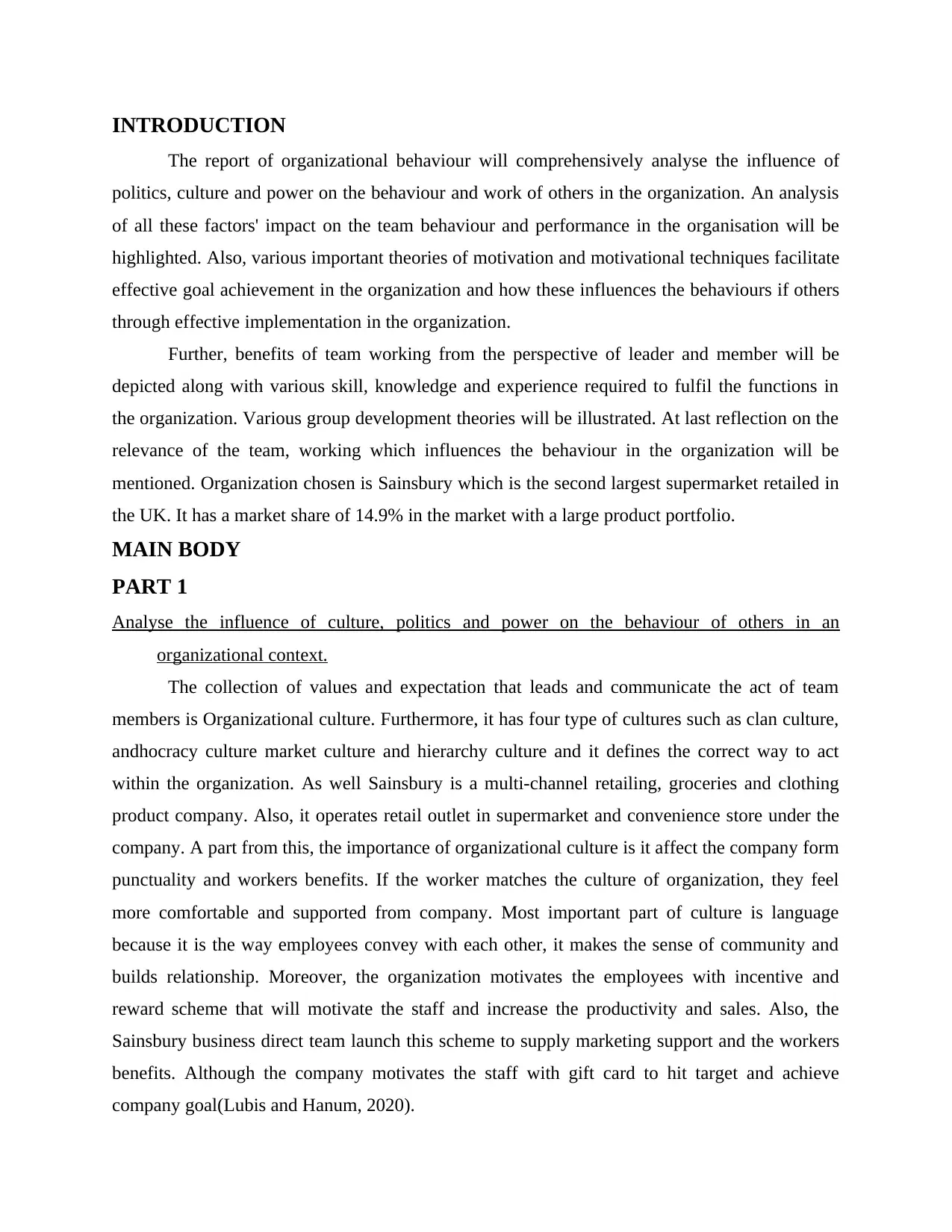
INTRODUCTION
The report of organizational behaviour will comprehensively analyse the influence of
politics, culture and power on the behaviour and work of others in the organization. An analysis
of all these factors' impact on the team behaviour and performance in the organisation will be
highlighted. Also, various important theories of motivation and motivational techniques facilitate
effective goal achievement in the organization and how these influences the behaviours if others
through effective implementation in the organization.
Further, benefits of team working from the perspective of leader and member will be
depicted along with various skill, knowledge and experience required to fulfil the functions in
the organization. Various group development theories will be illustrated. At last reflection on the
relevance of the team, working which influences the behaviour in the organization will be
mentioned. Organization chosen is Sainsbury which is the second largest supermarket retailed in
the UK. It has a market share of 14.9% in the market with a large product portfolio.
MAIN BODY
PART 1
Analyse the influence of culture, politics and power on the behaviour of others in an
organizational context.
The collection of values and expectation that leads and communicate the act of team
members is Organizational culture. Furthermore, it has four type of cultures such as clan culture,
andhocracy culture market culture and hierarchy culture and it defines the correct way to act
within the organization. As well Sainsbury is a multi-channel retailing, groceries and clothing
product company. Also, it operates retail outlet in supermarket and convenience store under the
company. A part from this, the importance of organizational culture is it affect the company form
punctuality and workers benefits. If the worker matches the culture of organization, they feel
more comfortable and supported from company. Most important part of culture is language
because it is the way employees convey with each other, it makes the sense of community and
builds relationship. Moreover, the organization motivates the employees with incentive and
reward scheme that will motivate the staff and increase the productivity and sales. Also, the
Sainsbury business direct team launch this scheme to supply marketing support and the workers
benefits. Although the company motivates the staff with gift card to hit target and achieve
company goal(Lubis and Hanum, 2020).
The report of organizational behaviour will comprehensively analyse the influence of
politics, culture and power on the behaviour and work of others in the organization. An analysis
of all these factors' impact on the team behaviour and performance in the organisation will be
highlighted. Also, various important theories of motivation and motivational techniques facilitate
effective goal achievement in the organization and how these influences the behaviours if others
through effective implementation in the organization.
Further, benefits of team working from the perspective of leader and member will be
depicted along with various skill, knowledge and experience required to fulfil the functions in
the organization. Various group development theories will be illustrated. At last reflection on the
relevance of the team, working which influences the behaviour in the organization will be
mentioned. Organization chosen is Sainsbury which is the second largest supermarket retailed in
the UK. It has a market share of 14.9% in the market with a large product portfolio.
MAIN BODY
PART 1
Analyse the influence of culture, politics and power on the behaviour of others in an
organizational context.
The collection of values and expectation that leads and communicate the act of team
members is Organizational culture. Furthermore, it has four type of cultures such as clan culture,
andhocracy culture market culture and hierarchy culture and it defines the correct way to act
within the organization. As well Sainsbury is a multi-channel retailing, groceries and clothing
product company. Also, it operates retail outlet in supermarket and convenience store under the
company. A part from this, the importance of organizational culture is it affect the company form
punctuality and workers benefits. If the worker matches the culture of organization, they feel
more comfortable and supported from company. Most important part of culture is language
because it is the way employees convey with each other, it makes the sense of community and
builds relationship. Moreover, the organization motivates the employees with incentive and
reward scheme that will motivate the staff and increase the productivity and sales. Also, the
Sainsbury business direct team launch this scheme to supply marketing support and the workers
benefits. Although the company motivates the staff with gift card to hit target and achieve
company goal(Lubis and Hanum, 2020).
⊘ This is a preview!⊘
Do you want full access?
Subscribe today to unlock all pages.

Trusted by 1+ million students worldwide
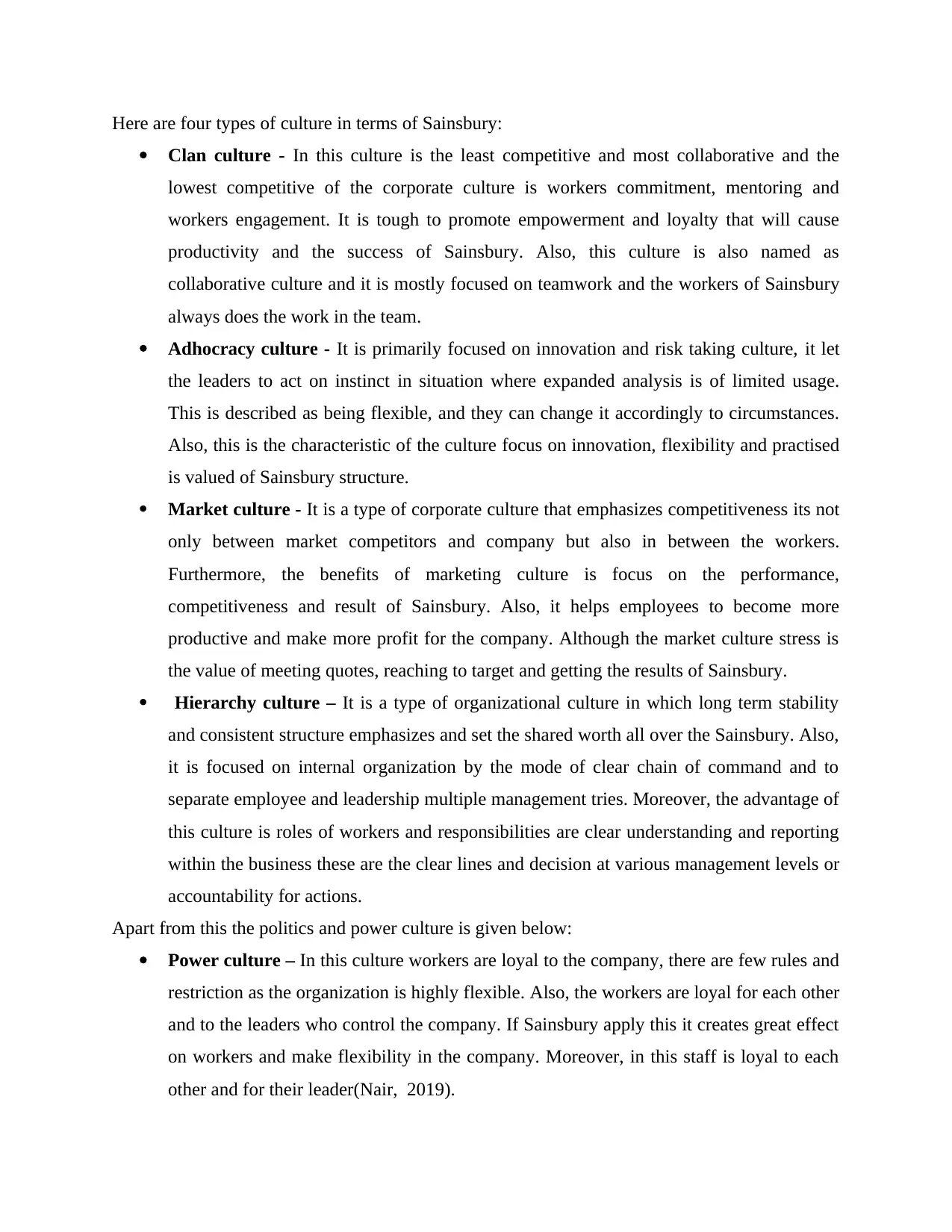
Here are four types of culture in terms of Sainsbury:
Clan culture - In this culture is the least competitive and most collaborative and the
lowest competitive of the corporate culture is workers commitment, mentoring and
workers engagement. It is tough to promote empowerment and loyalty that will cause
productivity and the success of Sainsbury. Also, this culture is also named as
collaborative culture and it is mostly focused on teamwork and the workers of Sainsbury
always does the work in the team.
Adhocracy culture - It is primarily focused on innovation and risk taking culture, it let
the leaders to act on instinct in situation where expanded analysis is of limited usage.
This is described as being flexible, and they can change it accordingly to circumstances.
Also, this is the characteristic of the culture focus on innovation, flexibility and practised
is valued of Sainsbury structure.
Market culture - It is a type of corporate culture that emphasizes competitiveness its not
only between market competitors and company but also in between the workers.
Furthermore, the benefits of marketing culture is focus on the performance,
competitiveness and result of Sainsbury. Also, it helps employees to become more
productive and make more profit for the company. Although the market culture stress is
the value of meeting quotes, reaching to target and getting the results of Sainsbury.
Hierarchy culture – It is a type of organizational culture in which long term stability
and consistent structure emphasizes and set the shared worth all over the Sainsbury. Also,
it is focused on internal organization by the mode of clear chain of command and to
separate employee and leadership multiple management tries. Moreover, the advantage of
this culture is roles of workers and responsibilities are clear understanding and reporting
within the business these are the clear lines and decision at various management levels or
accountability for actions.
Apart from this the politics and power culture is given below:
Power culture – In this culture workers are loyal to the company, there are few rules and
restriction as the organization is highly flexible. Also, the workers are loyal for each other
and to the leaders who control the company. If Sainsbury apply this it creates great effect
on workers and make flexibility in the company. Moreover, in this staff is loyal to each
other and for their leader(Nair, 2019).
Clan culture - In this culture is the least competitive and most collaborative and the
lowest competitive of the corporate culture is workers commitment, mentoring and
workers engagement. It is tough to promote empowerment and loyalty that will cause
productivity and the success of Sainsbury. Also, this culture is also named as
collaborative culture and it is mostly focused on teamwork and the workers of Sainsbury
always does the work in the team.
Adhocracy culture - It is primarily focused on innovation and risk taking culture, it let
the leaders to act on instinct in situation where expanded analysis is of limited usage.
This is described as being flexible, and they can change it accordingly to circumstances.
Also, this is the characteristic of the culture focus on innovation, flexibility and practised
is valued of Sainsbury structure.
Market culture - It is a type of corporate culture that emphasizes competitiveness its not
only between market competitors and company but also in between the workers.
Furthermore, the benefits of marketing culture is focus on the performance,
competitiveness and result of Sainsbury. Also, it helps employees to become more
productive and make more profit for the company. Although the market culture stress is
the value of meeting quotes, reaching to target and getting the results of Sainsbury.
Hierarchy culture – It is a type of organizational culture in which long term stability
and consistent structure emphasizes and set the shared worth all over the Sainsbury. Also,
it is focused on internal organization by the mode of clear chain of command and to
separate employee and leadership multiple management tries. Moreover, the advantage of
this culture is roles of workers and responsibilities are clear understanding and reporting
within the business these are the clear lines and decision at various management levels or
accountability for actions.
Apart from this the politics and power culture is given below:
Power culture – In this culture workers are loyal to the company, there are few rules and
restriction as the organization is highly flexible. Also, the workers are loyal for each other
and to the leaders who control the company. If Sainsbury apply this it creates great effect
on workers and make flexibility in the company. Moreover, in this staff is loyal to each
other and for their leader(Nair, 2019).
Paraphrase This Document
Need a fresh take? Get an instant paraphrase of this document with our AI Paraphraser
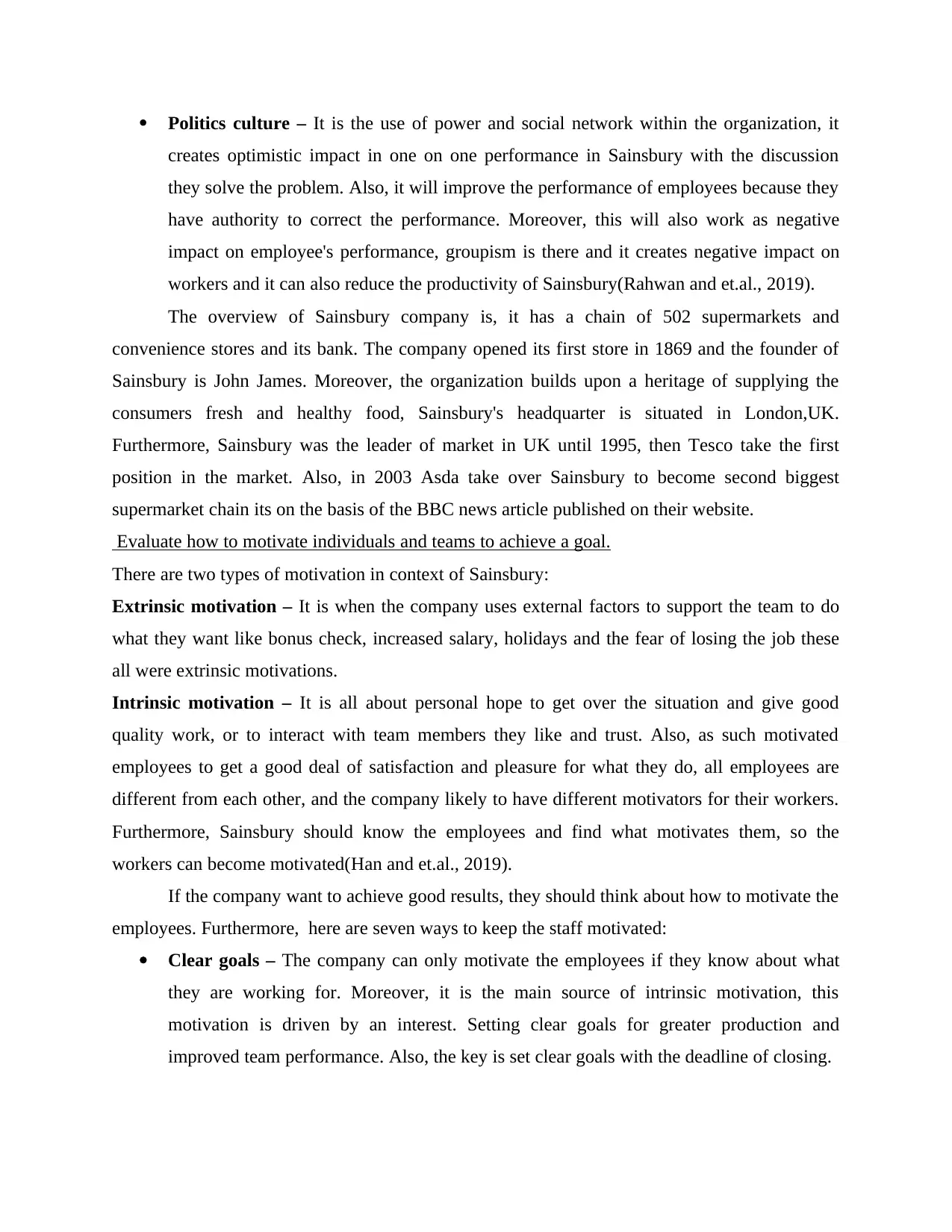
Politics culture – It is the use of power and social network within the organization, it
creates optimistic impact in one on one performance in Sainsbury with the discussion
they solve the problem. Also, it will improve the performance of employees because they
have authority to correct the performance. Moreover, this will also work as negative
impact on employee's performance, groupism is there and it creates negative impact on
workers and it can also reduce the productivity of Sainsbury(Rahwan and et.al., 2019).
The overview of Sainsbury company is, it has a chain of 502 supermarkets and
convenience stores and its bank. The company opened its first store in 1869 and the founder of
Sainsbury is John James. Moreover, the organization builds upon a heritage of supplying the
consumers fresh and healthy food, Sainsbury's headquarter is situated in London,UK.
Furthermore, Sainsbury was the leader of market in UK until 1995, then Tesco take the first
position in the market. Also, in 2003 Asda take over Sainsbury to become second biggest
supermarket chain its on the basis of the BBC news article published on their website.
Evaluate how to motivate individuals and teams to achieve a goal.
There are two types of motivation in context of Sainsbury:
Extrinsic motivation – It is when the company uses external factors to support the team to do
what they want like bonus check, increased salary, holidays and the fear of losing the job these
all were extrinsic motivations.
Intrinsic motivation – It is all about personal hope to get over the situation and give good
quality work, or to interact with team members they like and trust. Also, as such motivated
employees to get a good deal of satisfaction and pleasure for what they do, all employees are
different from each other, and the company likely to have different motivators for their workers.
Furthermore, Sainsbury should know the employees and find what motivates them, so the
workers can become motivated(Han and et.al., 2019).
If the company want to achieve good results, they should think about how to motivate the
employees. Furthermore, here are seven ways to keep the staff motivated:
Clear goals – The company can only motivate the employees if they know about what
they are working for. Moreover, it is the main source of intrinsic motivation, this
motivation is driven by an interest. Setting clear goals for greater production and
improved team performance. Also, the key is set clear goals with the deadline of closing.
creates optimistic impact in one on one performance in Sainsbury with the discussion
they solve the problem. Also, it will improve the performance of employees because they
have authority to correct the performance. Moreover, this will also work as negative
impact on employee's performance, groupism is there and it creates negative impact on
workers and it can also reduce the productivity of Sainsbury(Rahwan and et.al., 2019).
The overview of Sainsbury company is, it has a chain of 502 supermarkets and
convenience stores and its bank. The company opened its first store in 1869 and the founder of
Sainsbury is John James. Moreover, the organization builds upon a heritage of supplying the
consumers fresh and healthy food, Sainsbury's headquarter is situated in London,UK.
Furthermore, Sainsbury was the leader of market in UK until 1995, then Tesco take the first
position in the market. Also, in 2003 Asda take over Sainsbury to become second biggest
supermarket chain its on the basis of the BBC news article published on their website.
Evaluate how to motivate individuals and teams to achieve a goal.
There are two types of motivation in context of Sainsbury:
Extrinsic motivation – It is when the company uses external factors to support the team to do
what they want like bonus check, increased salary, holidays and the fear of losing the job these
all were extrinsic motivations.
Intrinsic motivation – It is all about personal hope to get over the situation and give good
quality work, or to interact with team members they like and trust. Also, as such motivated
employees to get a good deal of satisfaction and pleasure for what they do, all employees are
different from each other, and the company likely to have different motivators for their workers.
Furthermore, Sainsbury should know the employees and find what motivates them, so the
workers can become motivated(Han and et.al., 2019).
If the company want to achieve good results, they should think about how to motivate the
employees. Furthermore, here are seven ways to keep the staff motivated:
Clear goals – The company can only motivate the employees if they know about what
they are working for. Moreover, it is the main source of intrinsic motivation, this
motivation is driven by an interest. Setting clear goals for greater production and
improved team performance. Also, the key is set clear goals with the deadline of closing.
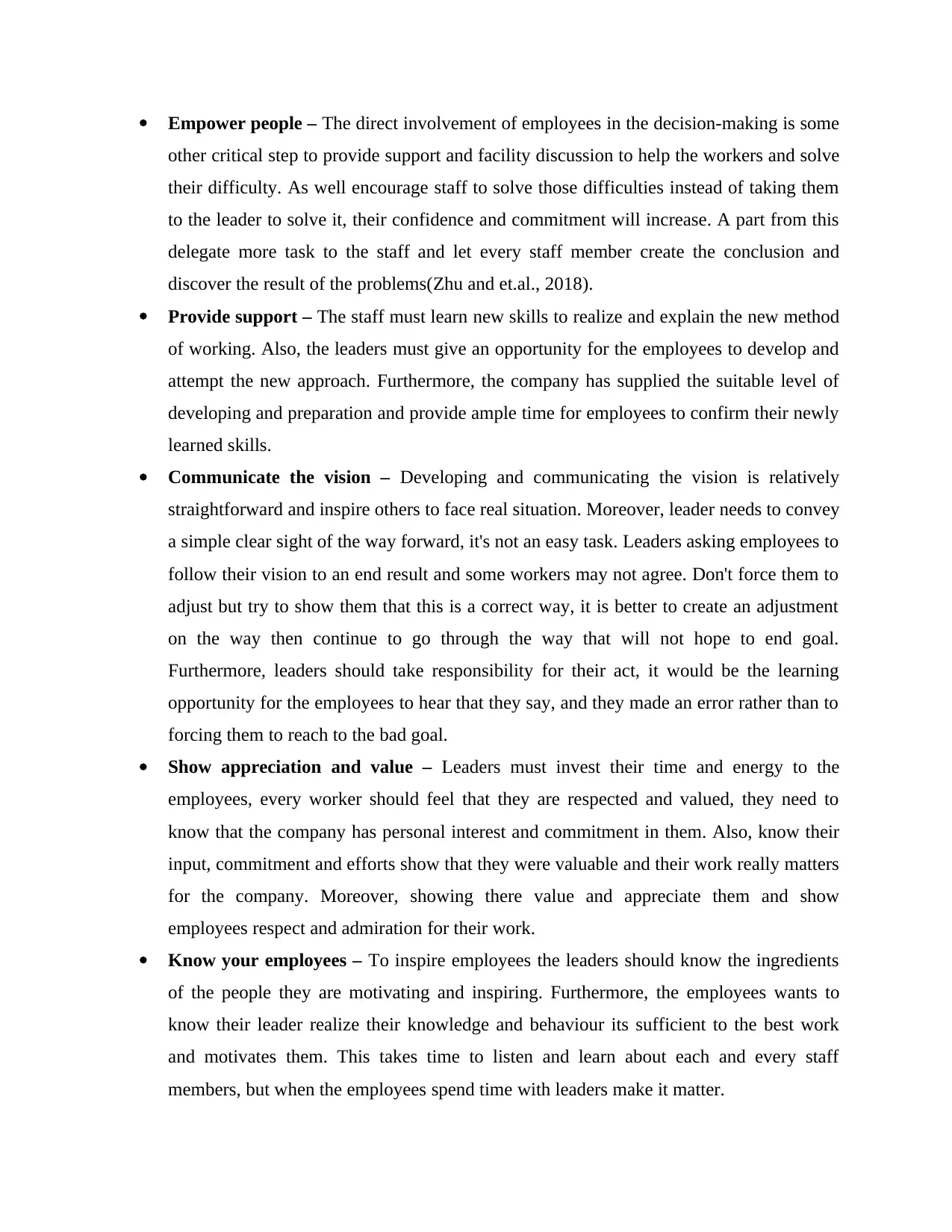
Empower people – The direct involvement of employees in the decision-making is some
other critical step to provide support and facility discussion to help the workers and solve
their difficulty. As well encourage staff to solve those difficulties instead of taking them
to the leader to solve it, their confidence and commitment will increase. A part from this
delegate more task to the staff and let every staff member create the conclusion and
discover the result of the problems(Zhu and et.al., 2018).
Provide support – The staff must learn new skills to realize and explain the new method
of working. Also, the leaders must give an opportunity for the employees to develop and
attempt the new approach. Furthermore, the company has supplied the suitable level of
developing and preparation and provide ample time for employees to confirm their newly
learned skills.
Communicate the vision – Developing and communicating the vision is relatively
straightforward and inspire others to face real situation. Moreover, leader needs to convey
a simple clear sight of the way forward, it's not an easy task. Leaders asking employees to
follow their vision to an end result and some workers may not agree. Don't force them to
adjust but try to show them that this is a correct way, it is better to create an adjustment
on the way then continue to go through the way that will not hope to end goal.
Furthermore, leaders should take responsibility for their act, it would be the learning
opportunity for the employees to hear that they say, and they made an error rather than to
forcing them to reach to the bad goal.
Show appreciation and value – Leaders must invest their time and energy to the
employees, every worker should feel that they are respected and valued, they need to
know that the company has personal interest and commitment in them. Also, know their
input, commitment and efforts show that they were valuable and their work really matters
for the company. Moreover, showing there value and appreciate them and show
employees respect and admiration for their work.
Know your employees – To inspire employees the leaders should know the ingredients
of the people they are motivating and inspiring. Furthermore, the employees wants to
know their leader realize their knowledge and behaviour its sufficient to the best work
and motivates them. This takes time to listen and learn about each and every staff
members, but when the employees spend time with leaders make it matter.
other critical step to provide support and facility discussion to help the workers and solve
their difficulty. As well encourage staff to solve those difficulties instead of taking them
to the leader to solve it, their confidence and commitment will increase. A part from this
delegate more task to the staff and let every staff member create the conclusion and
discover the result of the problems(Zhu and et.al., 2018).
Provide support – The staff must learn new skills to realize and explain the new method
of working. Also, the leaders must give an opportunity for the employees to develop and
attempt the new approach. Furthermore, the company has supplied the suitable level of
developing and preparation and provide ample time for employees to confirm their newly
learned skills.
Communicate the vision – Developing and communicating the vision is relatively
straightforward and inspire others to face real situation. Moreover, leader needs to convey
a simple clear sight of the way forward, it's not an easy task. Leaders asking employees to
follow their vision to an end result and some workers may not agree. Don't force them to
adjust but try to show them that this is a correct way, it is better to create an adjustment
on the way then continue to go through the way that will not hope to end goal.
Furthermore, leaders should take responsibility for their act, it would be the learning
opportunity for the employees to hear that they say, and they made an error rather than to
forcing them to reach to the bad goal.
Show appreciation and value – Leaders must invest their time and energy to the
employees, every worker should feel that they are respected and valued, they need to
know that the company has personal interest and commitment in them. Also, know their
input, commitment and efforts show that they were valuable and their work really matters
for the company. Moreover, showing there value and appreciate them and show
employees respect and admiration for their work.
Know your employees – To inspire employees the leaders should know the ingredients
of the people they are motivating and inspiring. Furthermore, the employees wants to
know their leader realize their knowledge and behaviour its sufficient to the best work
and motivates them. This takes time to listen and learn about each and every staff
members, but when the employees spend time with leaders make it matter.
⊘ This is a preview!⊘
Do you want full access?
Subscribe today to unlock all pages.

Trusted by 1+ million students worldwide
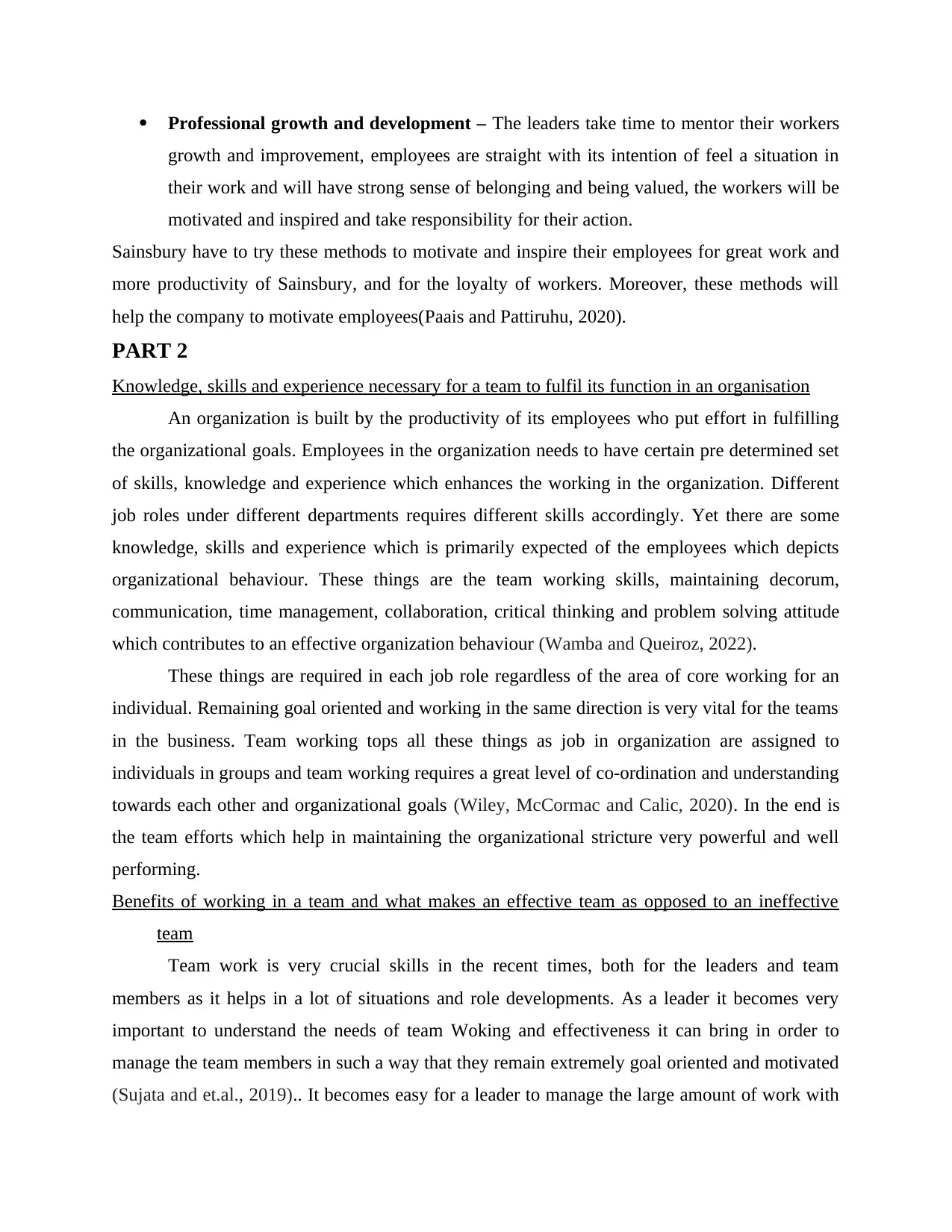
Professional growth and development – The leaders take time to mentor their workers
growth and improvement, employees are straight with its intention of feel a situation in
their work and will have strong sense of belonging and being valued, the workers will be
motivated and inspired and take responsibility for their action.
Sainsbury have to try these methods to motivate and inspire their employees for great work and
more productivity of Sainsbury, and for the loyalty of workers. Moreover, these methods will
help the company to motivate employees(Paais and Pattiruhu, 2020).
PART 2
Knowledge, skills and experience necessary for a team to fulfil its function in an organisation
An organization is built by the productivity of its employees who put effort in fulfilling
the organizational goals. Employees in the organization needs to have certain pre determined set
of skills, knowledge and experience which enhances the working in the organization. Different
job roles under different departments requires different skills accordingly. Yet there are some
knowledge, skills and experience which is primarily expected of the employees which depicts
organizational behaviour. These things are the team working skills, maintaining decorum,
communication, time management, collaboration, critical thinking and problem solving attitude
which contributes to an effective organization behaviour (Wamba and Queiroz, 2022).
These things are required in each job role regardless of the area of core working for an
individual. Remaining goal oriented and working in the same direction is very vital for the teams
in the business. Team working tops all these things as job in organization are assigned to
individuals in groups and team working requires a great level of co-ordination and understanding
towards each other and organizational goals (Wiley, McCormac and Calic, 2020). In the end is
the team efforts which help in maintaining the organizational stricture very powerful and well
performing.
Benefits of working in a team and what makes an effective team as opposed to an ineffective
team
Team work is very crucial skills in the recent times, both for the leaders and team
members as it helps in a lot of situations and role developments. As a leader it becomes very
important to understand the needs of team Woking and effectiveness it can bring in order to
manage the team members in such a way that they remain extremely goal oriented and motivated
(Sujata and et.al., 2019).. It becomes easy for a leader to manage the large amount of work with
growth and improvement, employees are straight with its intention of feel a situation in
their work and will have strong sense of belonging and being valued, the workers will be
motivated and inspired and take responsibility for their action.
Sainsbury have to try these methods to motivate and inspire their employees for great work and
more productivity of Sainsbury, and for the loyalty of workers. Moreover, these methods will
help the company to motivate employees(Paais and Pattiruhu, 2020).
PART 2
Knowledge, skills and experience necessary for a team to fulfil its function in an organisation
An organization is built by the productivity of its employees who put effort in fulfilling
the organizational goals. Employees in the organization needs to have certain pre determined set
of skills, knowledge and experience which enhances the working in the organization. Different
job roles under different departments requires different skills accordingly. Yet there are some
knowledge, skills and experience which is primarily expected of the employees which depicts
organizational behaviour. These things are the team working skills, maintaining decorum,
communication, time management, collaboration, critical thinking and problem solving attitude
which contributes to an effective organization behaviour (Wamba and Queiroz, 2022).
These things are required in each job role regardless of the area of core working for an
individual. Remaining goal oriented and working in the same direction is very vital for the teams
in the business. Team working tops all these things as job in organization are assigned to
individuals in groups and team working requires a great level of co-ordination and understanding
towards each other and organizational goals (Wiley, McCormac and Calic, 2020). In the end is
the team efforts which help in maintaining the organizational stricture very powerful and well
performing.
Benefits of working in a team and what makes an effective team as opposed to an ineffective
team
Team work is very crucial skills in the recent times, both for the leaders and team
members as it helps in a lot of situations and role developments. As a leader it becomes very
important to understand the needs of team Woking and effectiveness it can bring in order to
manage the team members in such a way that they remain extremely goal oriented and motivated
(Sujata and et.al., 2019).. It becomes easy for a leader to manage the large amount of work with
Paraphrase This Document
Need a fresh take? Get an instant paraphrase of this document with our AI Paraphraser
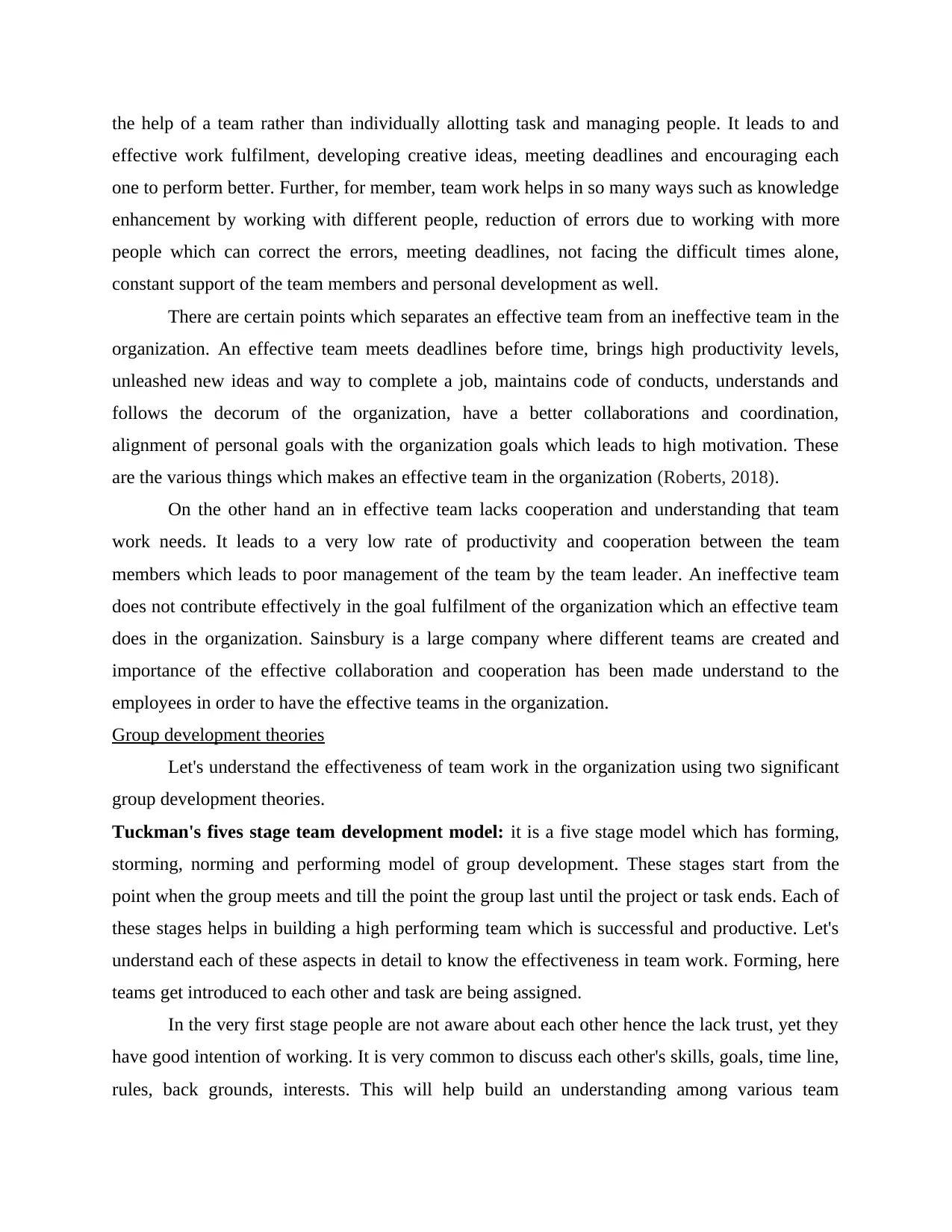
the help of a team rather than individually allotting task and managing people. It leads to and
effective work fulfilment, developing creative ideas, meeting deadlines and encouraging each
one to perform better. Further, for member, team work helps in so many ways such as knowledge
enhancement by working with different people, reduction of errors due to working with more
people which can correct the errors, meeting deadlines, not facing the difficult times alone,
constant support of the team members and personal development as well.
There are certain points which separates an effective team from an ineffective team in the
organization. An effective team meets deadlines before time, brings high productivity levels,
unleashed new ideas and way to complete a job, maintains code of conducts, understands and
follows the decorum of the organization, have a better collaborations and coordination,
alignment of personal goals with the organization goals which leads to high motivation. These
are the various things which makes an effective team in the organization (Roberts, 2018).
On the other hand an in effective team lacks cooperation and understanding that team
work needs. It leads to a very low rate of productivity and cooperation between the team
members which leads to poor management of the team by the team leader. An ineffective team
does not contribute effectively in the goal fulfilment of the organization which an effective team
does in the organization. Sainsbury is a large company where different teams are created and
importance of the effective collaboration and cooperation has been made understand to the
employees in order to have the effective teams in the organization.
Group development theories
Let's understand the effectiveness of team work in the organization using two significant
group development theories.
Tuckman's fives stage team development model: it is a five stage model which has forming,
storming, norming and performing model of group development. These stages start from the
point when the group meets and till the point the group last until the project or task ends. Each of
these stages helps in building a high performing team which is successful and productive. Let's
understand each of these aspects in detail to know the effectiveness in team work. Forming, here
teams get introduced to each other and task are being assigned.
In the very first stage people are not aware about each other hence the lack trust, yet they
have good intention of working. It is very common to discuss each other's skills, goals, time line,
rules, back grounds, interests. This will help build an understanding among various team
effective work fulfilment, developing creative ideas, meeting deadlines and encouraging each
one to perform better. Further, for member, team work helps in so many ways such as knowledge
enhancement by working with different people, reduction of errors due to working with more
people which can correct the errors, meeting deadlines, not facing the difficult times alone,
constant support of the team members and personal development as well.
There are certain points which separates an effective team from an ineffective team in the
organization. An effective team meets deadlines before time, brings high productivity levels,
unleashed new ideas and way to complete a job, maintains code of conducts, understands and
follows the decorum of the organization, have a better collaborations and coordination,
alignment of personal goals with the organization goals which leads to high motivation. These
are the various things which makes an effective team in the organization (Roberts, 2018).
On the other hand an in effective team lacks cooperation and understanding that team
work needs. It leads to a very low rate of productivity and cooperation between the team
members which leads to poor management of the team by the team leader. An ineffective team
does not contribute effectively in the goal fulfilment of the organization which an effective team
does in the organization. Sainsbury is a large company where different teams are created and
importance of the effective collaboration and cooperation has been made understand to the
employees in order to have the effective teams in the organization.
Group development theories
Let's understand the effectiveness of team work in the organization using two significant
group development theories.
Tuckman's fives stage team development model: it is a five stage model which has forming,
storming, norming and performing model of group development. These stages start from the
point when the group meets and till the point the group last until the project or task ends. Each of
these stages helps in building a high performing team which is successful and productive. Let's
understand each of these aspects in detail to know the effectiveness in team work. Forming, here
teams get introduced to each other and task are being assigned.
In the very first stage people are not aware about each other hence the lack trust, yet they
have good intention of working. It is very common to discuss each other's skills, goals, time line,
rules, back grounds, interests. This will help build an understanding among various team
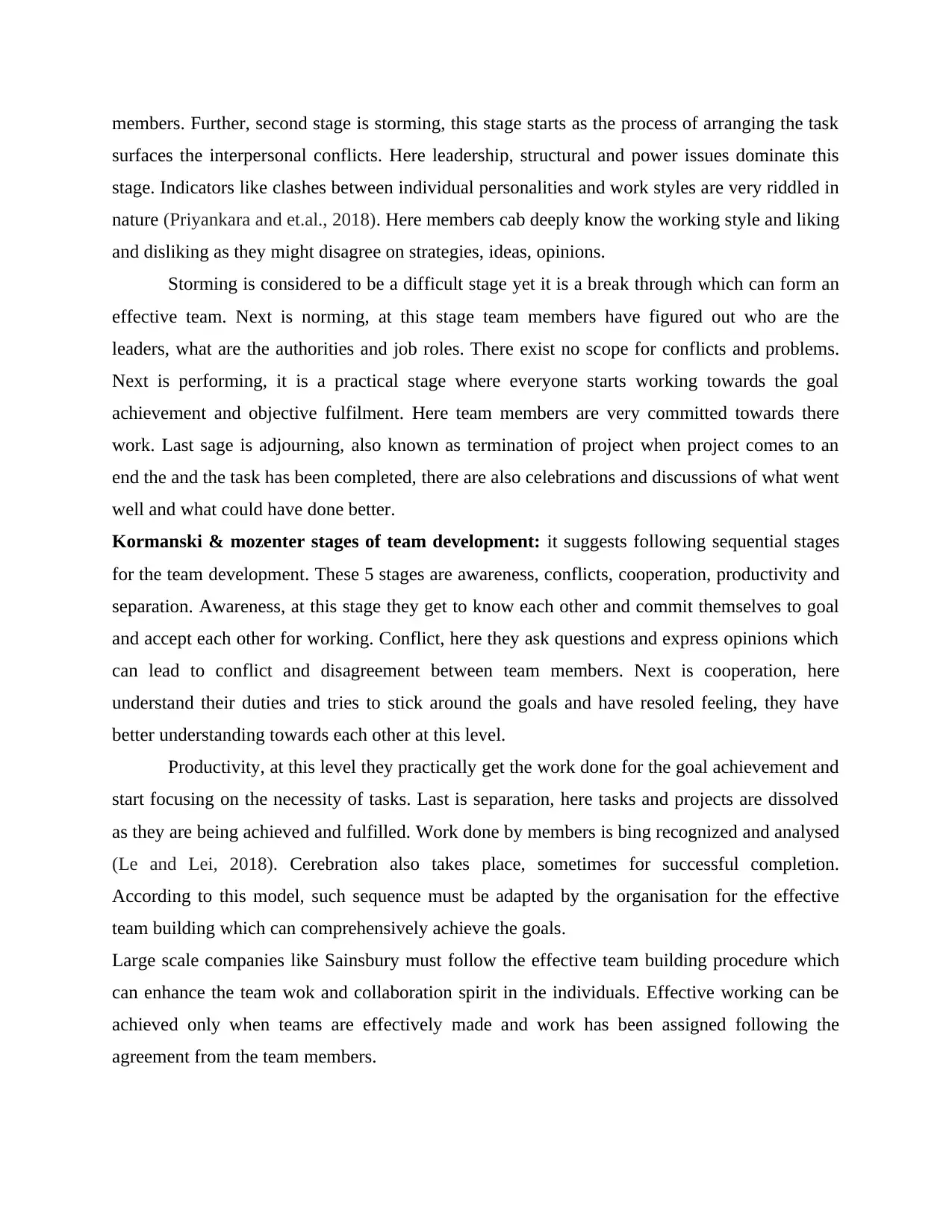
members. Further, second stage is storming, this stage starts as the process of arranging the task
surfaces the interpersonal conflicts. Here leadership, structural and power issues dominate this
stage. Indicators like clashes between individual personalities and work styles are very riddled in
nature (Priyankara and et.al., 2018). Here members cab deeply know the working style and liking
and disliking as they might disagree on strategies, ideas, opinions.
Storming is considered to be a difficult stage yet it is a break through which can form an
effective team. Next is norming, at this stage team members have figured out who are the
leaders, what are the authorities and job roles. There exist no scope for conflicts and problems.
Next is performing, it is a practical stage where everyone starts working towards the goal
achievement and objective fulfilment. Here team members are very committed towards there
work. Last sage is adjourning, also known as termination of project when project comes to an
end the and the task has been completed, there are also celebrations and discussions of what went
well and what could have done better.
Kormanski & mozenter stages of team development: it suggests following sequential stages
for the team development. These 5 stages are awareness, conflicts, cooperation, productivity and
separation. Awareness, at this stage they get to know each other and commit themselves to goal
and accept each other for working. Conflict, here they ask questions and express opinions which
can lead to conflict and disagreement between team members. Next is cooperation, here
understand their duties and tries to stick around the goals and have resoled feeling, they have
better understanding towards each other at this level.
Productivity, at this level they practically get the work done for the goal achievement and
start focusing on the necessity of tasks. Last is separation, here tasks and projects are dissolved
as they are being achieved and fulfilled. Work done by members is bing recognized and analysed
(Le and Lei, 2018). Cerebration also takes place, sometimes for successful completion.
According to this model, such sequence must be adapted by the organisation for the effective
team building which can comprehensively achieve the goals.
Large scale companies like Sainsbury must follow the effective team building procedure which
can enhance the team wok and collaboration spirit in the individuals. Effective working can be
achieved only when teams are effectively made and work has been assigned following the
agreement from the team members.
surfaces the interpersonal conflicts. Here leadership, structural and power issues dominate this
stage. Indicators like clashes between individual personalities and work styles are very riddled in
nature (Priyankara and et.al., 2018). Here members cab deeply know the working style and liking
and disliking as they might disagree on strategies, ideas, opinions.
Storming is considered to be a difficult stage yet it is a break through which can form an
effective team. Next is norming, at this stage team members have figured out who are the
leaders, what are the authorities and job roles. There exist no scope for conflicts and problems.
Next is performing, it is a practical stage where everyone starts working towards the goal
achievement and objective fulfilment. Here team members are very committed towards there
work. Last sage is adjourning, also known as termination of project when project comes to an
end the and the task has been completed, there are also celebrations and discussions of what went
well and what could have done better.
Kormanski & mozenter stages of team development: it suggests following sequential stages
for the team development. These 5 stages are awareness, conflicts, cooperation, productivity and
separation. Awareness, at this stage they get to know each other and commit themselves to goal
and accept each other for working. Conflict, here they ask questions and express opinions which
can lead to conflict and disagreement between team members. Next is cooperation, here
understand their duties and tries to stick around the goals and have resoled feeling, they have
better understanding towards each other at this level.
Productivity, at this level they practically get the work done for the goal achievement and
start focusing on the necessity of tasks. Last is separation, here tasks and projects are dissolved
as they are being achieved and fulfilled. Work done by members is bing recognized and analysed
(Le and Lei, 2018). Cerebration also takes place, sometimes for successful completion.
According to this model, such sequence must be adapted by the organisation for the effective
team building which can comprehensively achieve the goals.
Large scale companies like Sainsbury must follow the effective team building procedure which
can enhance the team wok and collaboration spirit in the individuals. Effective working can be
achieved only when teams are effectively made and work has been assigned following the
agreement from the team members.
⊘ This is a preview!⊘
Do you want full access?
Subscribe today to unlock all pages.

Trusted by 1+ million students worldwide
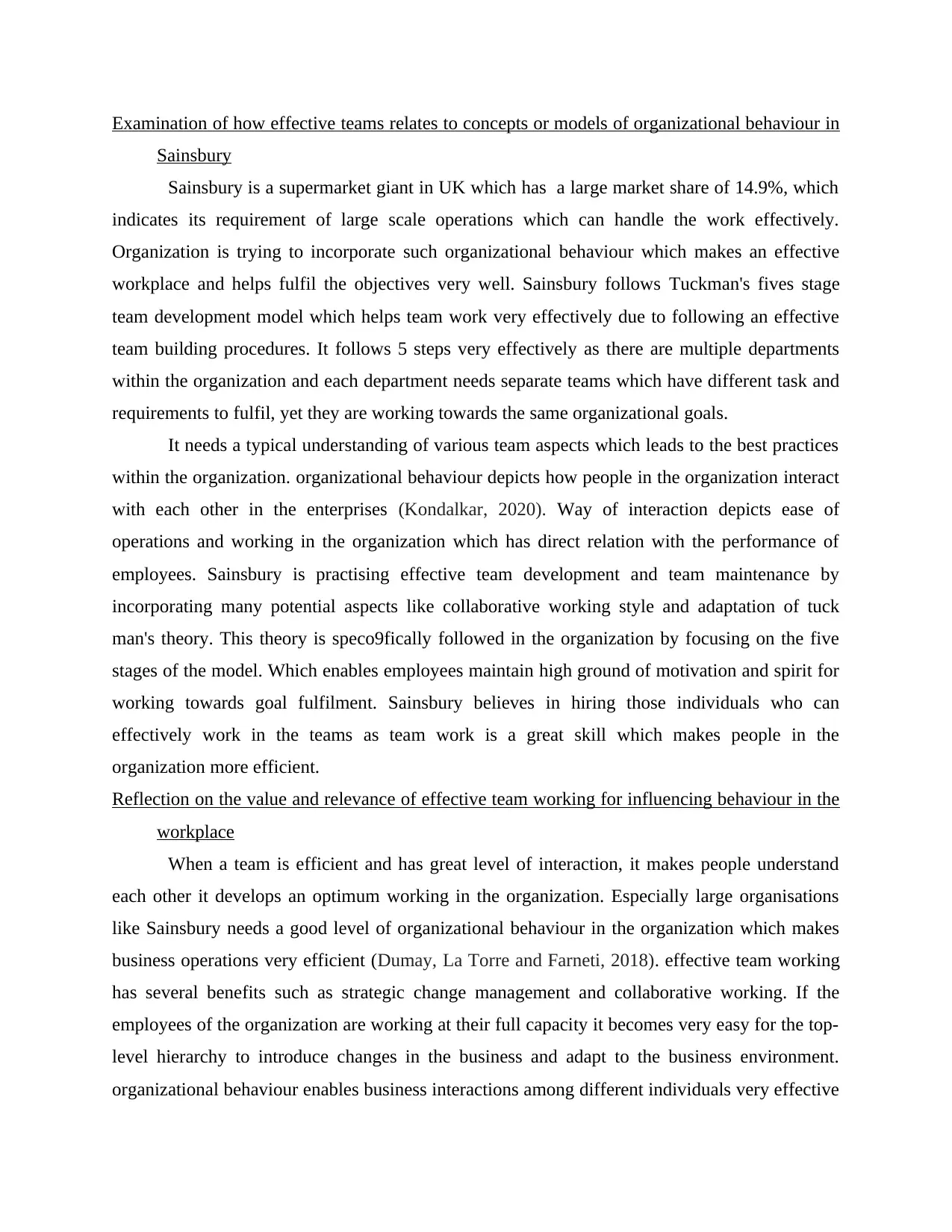
Examination of how effective teams relates to concepts or models of organizational behaviour in
Sainsbury
Sainsbury is a supermarket giant in UK which has a large market share of 14.9%, which
indicates its requirement of large scale operations which can handle the work effectively.
Organization is trying to incorporate such organizational behaviour which makes an effective
workplace and helps fulfil the objectives very well. Sainsbury follows Tuckman's fives stage
team development model which helps team work very effectively due to following an effective
team building procedures. It follows 5 steps very effectively as there are multiple departments
within the organization and each department needs separate teams which have different task and
requirements to fulfil, yet they are working towards the same organizational goals.
It needs a typical understanding of various team aspects which leads to the best practices
within the organization. organizational behaviour depicts how people in the organization interact
with each other in the enterprises (Kondalkar, 2020). Way of interaction depicts ease of
operations and working in the organization which has direct relation with the performance of
employees. Sainsbury is practising effective team development and team maintenance by
incorporating many potential aspects like collaborative working style and adaptation of tuck
man's theory. This theory is speco9fically followed in the organization by focusing on the five
stages of the model. Which enables employees maintain high ground of motivation and spirit for
working towards goal fulfilment. Sainsbury believes in hiring those individuals who can
effectively work in the teams as team work is a great skill which makes people in the
organization more efficient.
Reflection on the value and relevance of effective team working for influencing behaviour in the
workplace
When a team is efficient and has great level of interaction, it makes people understand
each other it develops an optimum working in the organization. Especially large organisations
like Sainsbury needs a good level of organizational behaviour in the organization which makes
business operations very efficient (Dumay, La Torre and Farneti, 2018). effective team working
has several benefits such as strategic change management and collaborative working. If the
employees of the organization are working at their full capacity it becomes very easy for the top-
level hierarchy to introduce changes in the business and adapt to the business environment.
organizational behaviour enables business interactions among different individuals very effective
Sainsbury
Sainsbury is a supermarket giant in UK which has a large market share of 14.9%, which
indicates its requirement of large scale operations which can handle the work effectively.
Organization is trying to incorporate such organizational behaviour which makes an effective
workplace and helps fulfil the objectives very well. Sainsbury follows Tuckman's fives stage
team development model which helps team work very effectively due to following an effective
team building procedures. It follows 5 steps very effectively as there are multiple departments
within the organization and each department needs separate teams which have different task and
requirements to fulfil, yet they are working towards the same organizational goals.
It needs a typical understanding of various team aspects which leads to the best practices
within the organization. organizational behaviour depicts how people in the organization interact
with each other in the enterprises (Kondalkar, 2020). Way of interaction depicts ease of
operations and working in the organization which has direct relation with the performance of
employees. Sainsbury is practising effective team development and team maintenance by
incorporating many potential aspects like collaborative working style and adaptation of tuck
man's theory. This theory is speco9fically followed in the organization by focusing on the five
stages of the model. Which enables employees maintain high ground of motivation and spirit for
working towards goal fulfilment. Sainsbury believes in hiring those individuals who can
effectively work in the teams as team work is a great skill which makes people in the
organization more efficient.
Reflection on the value and relevance of effective team working for influencing behaviour in the
workplace
When a team is efficient and has great level of interaction, it makes people understand
each other it develops an optimum working in the organization. Especially large organisations
like Sainsbury needs a good level of organizational behaviour in the organization which makes
business operations very efficient (Dumay, La Torre and Farneti, 2018). effective team working
has several benefits such as strategic change management and collaborative working. If the
employees of the organization are working at their full capacity it becomes very easy for the top-
level hierarchy to introduce changes in the business and adapt to the business environment.
organizational behaviour enables business interactions among different individuals very effective
Paraphrase This Document
Need a fresh take? Get an instant paraphrase of this document with our AI Paraphraser
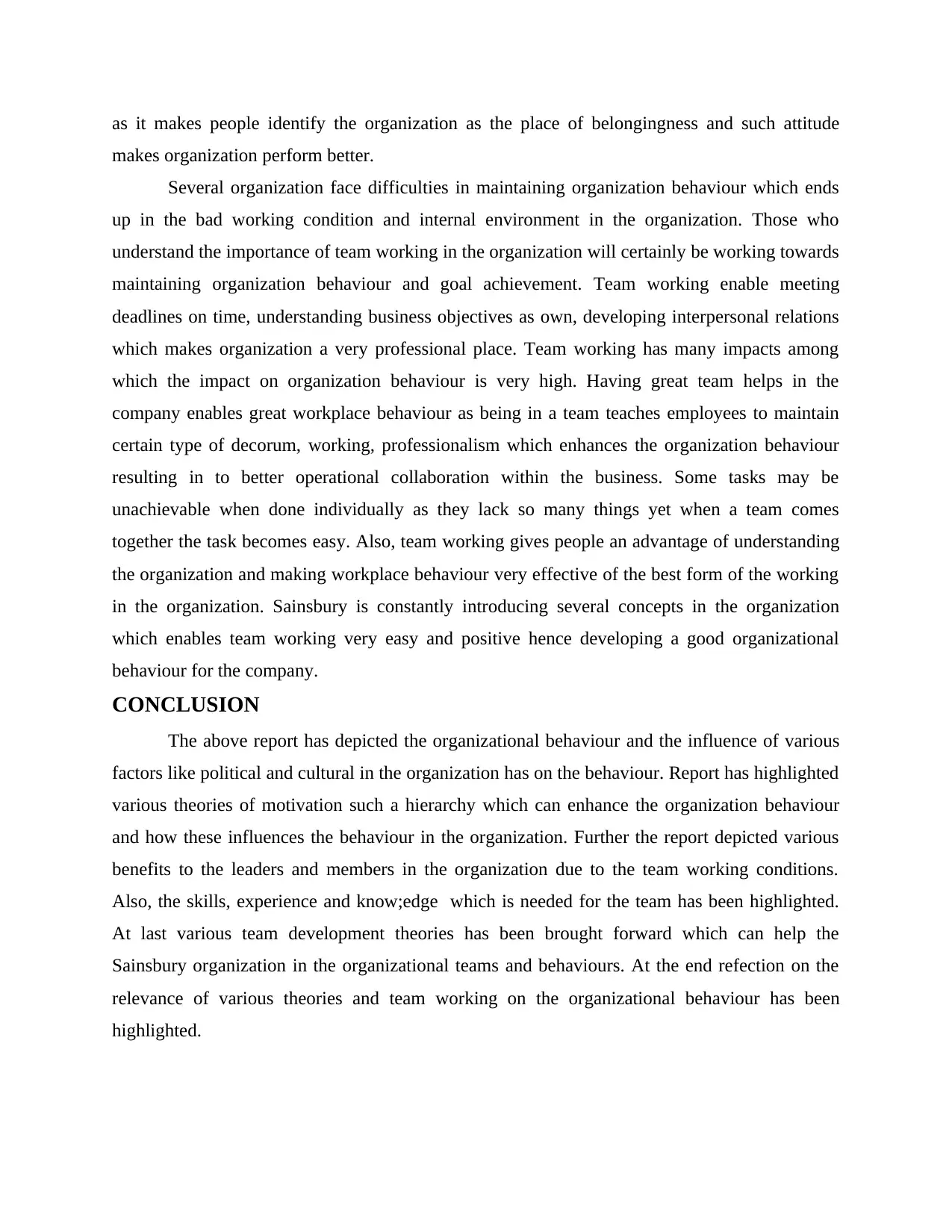
as it makes people identify the organization as the place of belongingness and such attitude
makes organization perform better.
Several organization face difficulties in maintaining organization behaviour which ends
up in the bad working condition and internal environment in the organization. Those who
understand the importance of team working in the organization will certainly be working towards
maintaining organization behaviour and goal achievement. Team working enable meeting
deadlines on time, understanding business objectives as own, developing interpersonal relations
which makes organization a very professional place. Team working has many impacts among
which the impact on organization behaviour is very high. Having great team helps in the
company enables great workplace behaviour as being in a team teaches employees to maintain
certain type of decorum, working, professionalism which enhances the organization behaviour
resulting in to better operational collaboration within the business. Some tasks may be
unachievable when done individually as they lack so many things yet when a team comes
together the task becomes easy. Also, team working gives people an advantage of understanding
the organization and making workplace behaviour very effective of the best form of the working
in the organization. Sainsbury is constantly introducing several concepts in the organization
which enables team working very easy and positive hence developing a good organizational
behaviour for the company.
CONCLUSION
The above report has depicted the organizational behaviour and the influence of various
factors like political and cultural in the organization has on the behaviour. Report has highlighted
various theories of motivation such a hierarchy which can enhance the organization behaviour
and how these influences the behaviour in the organization. Further the report depicted various
benefits to the leaders and members in the organization due to the team working conditions.
Also, the skills, experience and know;edge which is needed for the team has been highlighted.
At last various team development theories has been brought forward which can help the
Sainsbury organization in the organizational teams and behaviours. At the end refection on the
relevance of various theories and team working on the organizational behaviour has been
highlighted.
makes organization perform better.
Several organization face difficulties in maintaining organization behaviour which ends
up in the bad working condition and internal environment in the organization. Those who
understand the importance of team working in the organization will certainly be working towards
maintaining organization behaviour and goal achievement. Team working enable meeting
deadlines on time, understanding business objectives as own, developing interpersonal relations
which makes organization a very professional place. Team working has many impacts among
which the impact on organization behaviour is very high. Having great team helps in the
company enables great workplace behaviour as being in a team teaches employees to maintain
certain type of decorum, working, professionalism which enhances the organization behaviour
resulting in to better operational collaboration within the business. Some tasks may be
unachievable when done individually as they lack so many things yet when a team comes
together the task becomes easy. Also, team working gives people an advantage of understanding
the organization and making workplace behaviour very effective of the best form of the working
in the organization. Sainsbury is constantly introducing several concepts in the organization
which enables team working very easy and positive hence developing a good organizational
behaviour for the company.
CONCLUSION
The above report has depicted the organizational behaviour and the influence of various
factors like political and cultural in the organization has on the behaviour. Report has highlighted
various theories of motivation such a hierarchy which can enhance the organization behaviour
and how these influences the behaviour in the organization. Further the report depicted various
benefits to the leaders and members in the organization due to the team working conditions.
Also, the skills, experience and know;edge which is needed for the team has been highlighted.
At last various team development theories has been brought forward which can help the
Sainsbury organization in the organizational teams and behaviours. At the end refection on the
relevance of various theories and team working on the organizational behaviour has been
highlighted.
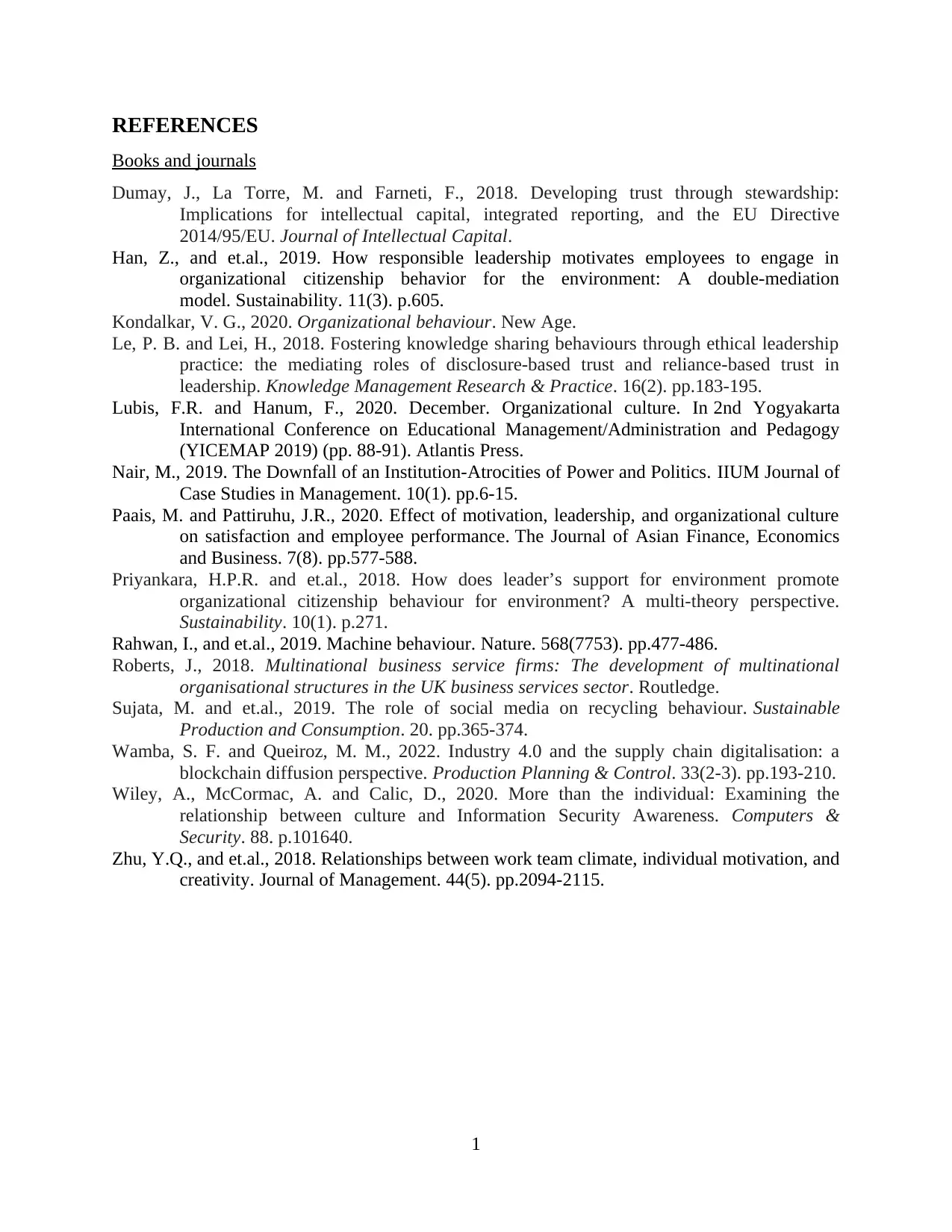
REFERENCES
Books and journals
Dumay, J., La Torre, M. and Farneti, F., 2018. Developing trust through stewardship:
Implications for intellectual capital, integrated reporting, and the EU Directive
2014/95/EU. Journal of Intellectual Capital.
Han, Z., and et.al., 2019. How responsible leadership motivates employees to engage in
organizational citizenship behavior for the environment: A double-mediation
model. Sustainability. 11(3). p.605.
Kondalkar, V. G., 2020. Organizational behaviour. New Age.
Le, P. B. and Lei, H., 2018. Fostering knowledge sharing behaviours through ethical leadership
practice: the mediating roles of disclosure-based trust and reliance-based trust in
leadership. Knowledge Management Research & Practice. 16(2). pp.183-195.
Lubis, F.R. and Hanum, F., 2020. December. Organizational culture. In 2nd Yogyakarta
International Conference on Educational Management/Administration and Pedagogy
(YICEMAP 2019) (pp. 88-91). Atlantis Press.
Nair, M., 2019. The Downfall of an Institution-Atrocities of Power and Politics. IIUM Journal of
Case Studies in Management. 10(1). pp.6-15.
Paais, M. and Pattiruhu, J.R., 2020. Effect of motivation, leadership, and organizational culture
on satisfaction and employee performance. The Journal of Asian Finance, Economics
and Business. 7(8). pp.577-588.
Priyankara, H.P.R. and et.al., 2018. How does leader’s support for environment promote
organizational citizenship behaviour for environment? A multi-theory perspective.
Sustainability. 10(1). p.271.
Rahwan, I., and et.al., 2019. Machine behaviour. Nature. 568(7753). pp.477-486.
Roberts, J., 2018. Multinational business service firms: The development of multinational
organisational structures in the UK business services sector. Routledge.
Sujata, M. and et.al., 2019. The role of social media on recycling behaviour. Sustainable
Production and Consumption. 20. pp.365-374.
Wamba, S. F. and Queiroz, M. M., 2022. Industry 4.0 and the supply chain digitalisation: a
blockchain diffusion perspective. Production Planning & Control. 33(2-3). pp.193-210.
Wiley, A., McCormac, A. and Calic, D., 2020. More than the individual: Examining the
relationship between culture and Information Security Awareness. Computers &
Security. 88. p.101640.
Zhu, Y.Q., and et.al., 2018. Relationships between work team climate, individual motivation, and
creativity. Journal of Management. 44(5). pp.2094-2115.
1
Books and journals
Dumay, J., La Torre, M. and Farneti, F., 2018. Developing trust through stewardship:
Implications for intellectual capital, integrated reporting, and the EU Directive
2014/95/EU. Journal of Intellectual Capital.
Han, Z., and et.al., 2019. How responsible leadership motivates employees to engage in
organizational citizenship behavior for the environment: A double-mediation
model. Sustainability. 11(3). p.605.
Kondalkar, V. G., 2020. Organizational behaviour. New Age.
Le, P. B. and Lei, H., 2018. Fostering knowledge sharing behaviours through ethical leadership
practice: the mediating roles of disclosure-based trust and reliance-based trust in
leadership. Knowledge Management Research & Practice. 16(2). pp.183-195.
Lubis, F.R. and Hanum, F., 2020. December. Organizational culture. In 2nd Yogyakarta
International Conference on Educational Management/Administration and Pedagogy
(YICEMAP 2019) (pp. 88-91). Atlantis Press.
Nair, M., 2019. The Downfall of an Institution-Atrocities of Power and Politics. IIUM Journal of
Case Studies in Management. 10(1). pp.6-15.
Paais, M. and Pattiruhu, J.R., 2020. Effect of motivation, leadership, and organizational culture
on satisfaction and employee performance. The Journal of Asian Finance, Economics
and Business. 7(8). pp.577-588.
Priyankara, H.P.R. and et.al., 2018. How does leader’s support for environment promote
organizational citizenship behaviour for environment? A multi-theory perspective.
Sustainability. 10(1). p.271.
Rahwan, I., and et.al., 2019. Machine behaviour. Nature. 568(7753). pp.477-486.
Roberts, J., 2018. Multinational business service firms: The development of multinational
organisational structures in the UK business services sector. Routledge.
Sujata, M. and et.al., 2019. The role of social media on recycling behaviour. Sustainable
Production and Consumption. 20. pp.365-374.
Wamba, S. F. and Queiroz, M. M., 2022. Industry 4.0 and the supply chain digitalisation: a
blockchain diffusion perspective. Production Planning & Control. 33(2-3). pp.193-210.
Wiley, A., McCormac, A. and Calic, D., 2020. More than the individual: Examining the
relationship between culture and Information Security Awareness. Computers &
Security. 88. p.101640.
Zhu, Y.Q., and et.al., 2018. Relationships between work team climate, individual motivation, and
creativity. Journal of Management. 44(5). pp.2094-2115.
1
⊘ This is a preview!⊘
Do you want full access?
Subscribe today to unlock all pages.

Trusted by 1+ million students worldwide
1 out of 12
Related Documents
Your All-in-One AI-Powered Toolkit for Academic Success.
+13062052269
info@desklib.com
Available 24*7 on WhatsApp / Email
![[object Object]](/_next/static/media/star-bottom.7253800d.svg)
Unlock your academic potential
Copyright © 2020–2025 A2Z Services. All Rights Reserved. Developed and managed by ZUCOL.




